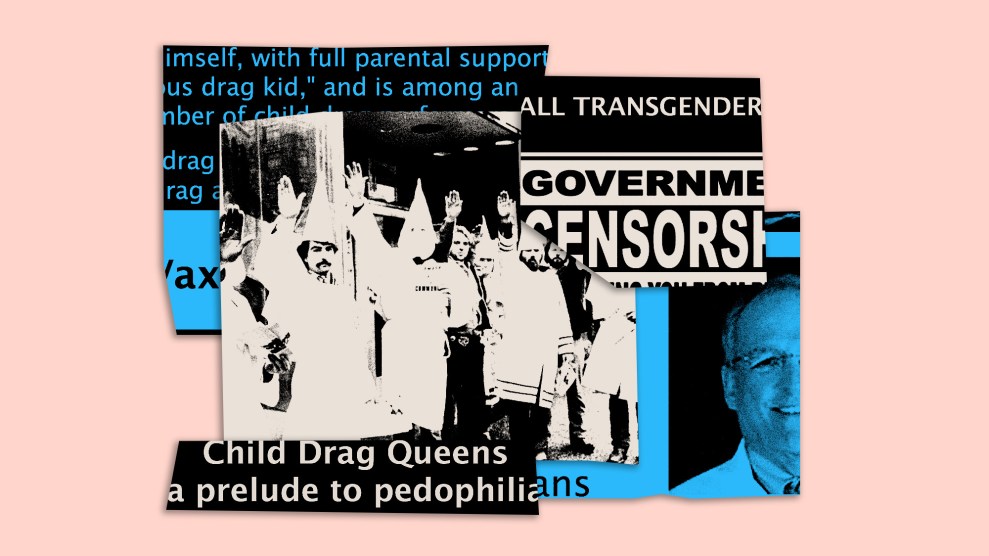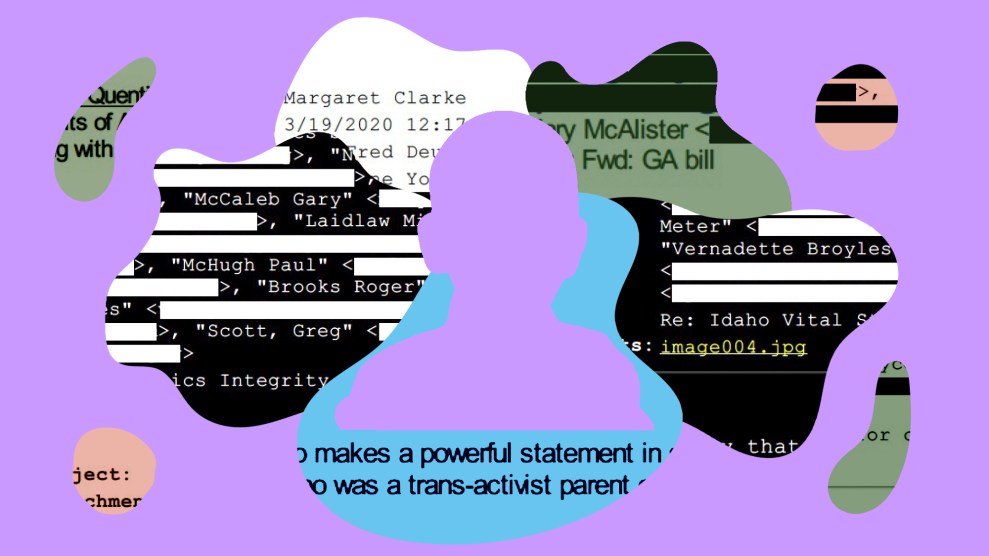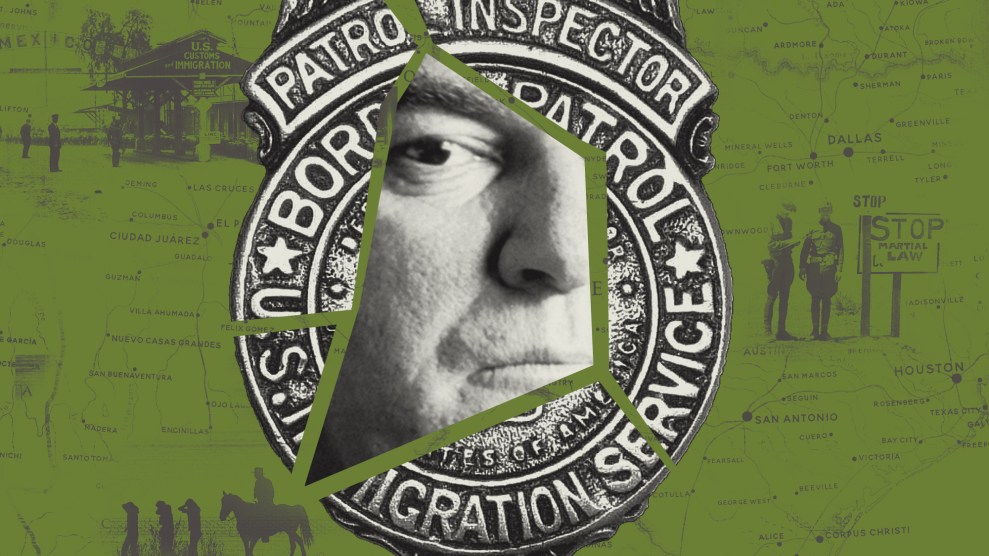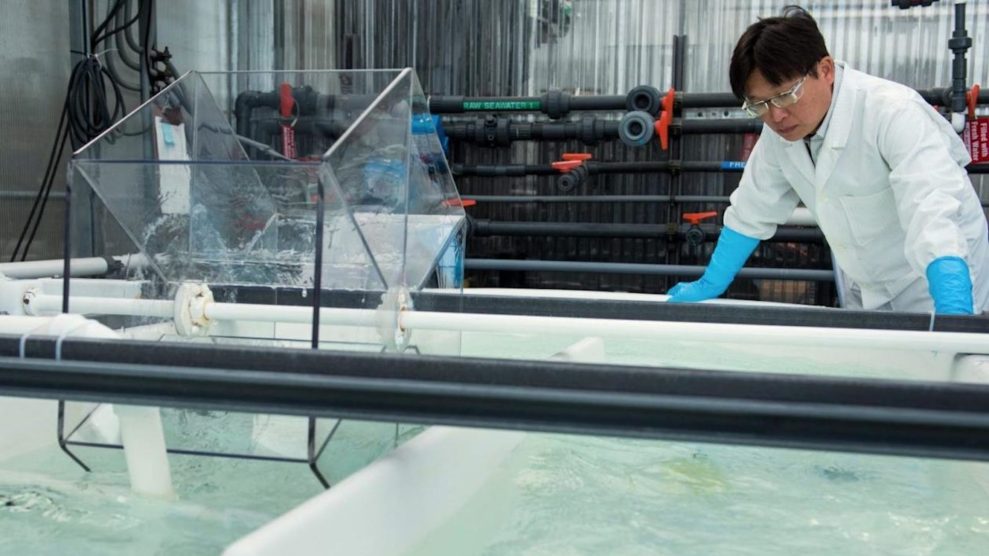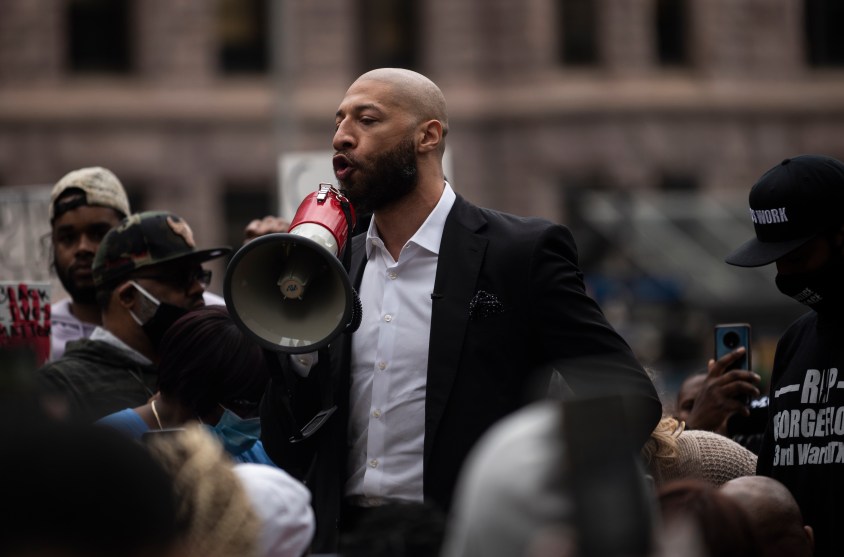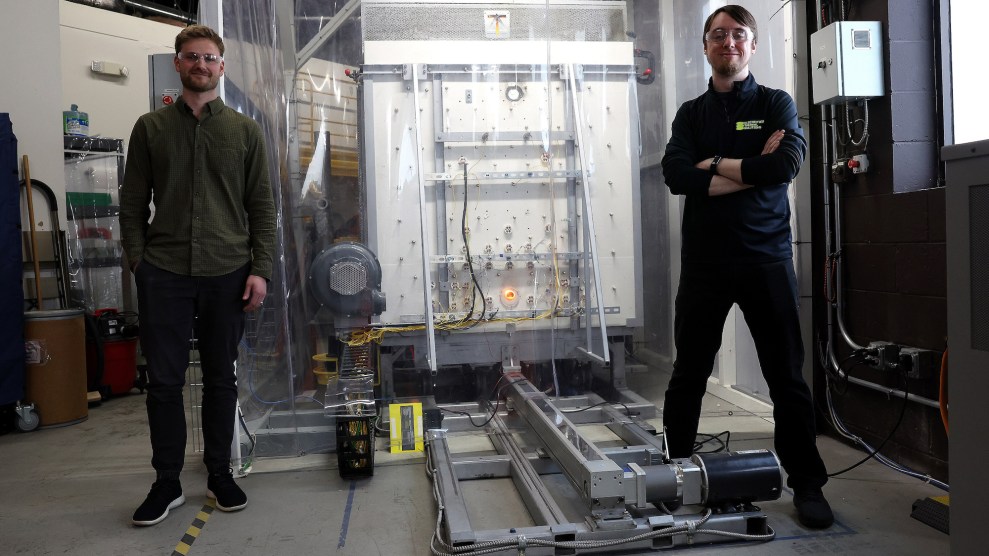The conversion therapists met last November at the south end of the Las Vegas Strip. Behind the closed doors and drawn blinds of a Hampton Inn conference room, a middle-aged woman wearing white stockings and a Virgin Mary blue dress issued a call to arms to the 20-some people in attendance. “In our current culture, in which children are being indoctrinated with transgender belief from the moment they’re out of the womb, if we are confronted with a gender-confused child, you must help,” declared Michelle Cretella, a board member of the Alliance for Therapeutic Choice and Scientific Integrity. “We must do something.”
Cretella was delivering a keynote speech at the first in-person conference in four years of the Alliance, which describes itself as a “professional and scientific organization” with “Judeo-Christian values.” Its purpose: to defend and promote the practice of conversion therapy by licensed counselors.
Not that they’d call what they do “conversion therapy.” That term lacks a precise definition, but it is used colloquially to describe attempts to shift a person’s sexual orientation or gender identity. In the 1960s, some psychologists tried to make gay men straight by pairing aversive stimuli, like electric shocks or chemically induced nausea, with images of gay porn—techniques that ran the risk of causing serious psychological damage even as they failed to change participants’ sexual orientation, researchers eventually concluded. Today, “conversion therapy” generally takes the form of verbal counseling. Participants are typically conservative Christians who engage voluntarily—motivated by internalized stigma, family pressure, and the belief that their feelings are incompatible with their faith. Others are children, brought into therapy by their parents.
The American Psychological Association (APA) has concluded that conversion therapy lacks “sufficient bases in scientific principles” and that people who have undergone it are “significantly more likely to experience suicidality and depression.” Similarly, the Substance Abuse and Mental Health Services Administration (SAMHSA), part of the Department of Health and Human Services, published a report concluding that “none of the existing research supports the premise that mental or behavioral health interventions can alter gender identity or sexual orientation. Interventions aimed at a fixed outcome, such as gender conformity or heterosexual orientation…are coercive, can be harmful, and should not be part of behavioral health treatment.”
Accordingly, the Alliance and the ideas it promotes have been relegated to the scientific and political fringes. In the 2010s, as acceptance of gay rights grew rapidly, 18 states and dozens of local governments passed laws forbidding mental health professionals from attempting conversion therapy on minors.
Yet by 2020, a new front had opened in the war against LGBTQ people. Republican state legislatures started passing laws targeting transgender and nonbinary children at school—restricting their access to bathrooms, barring them from participating in sports, and stopping educators from teaching about sexual orientation or gender identity. The most intense attacks have banned doctors from providing the treatments for gender dysphoria backed by all major US medical associations. Nearly 114,000 trans youth live in states where access to puberty blockers and hormone therapy has been wiped out.
Last year, I received leaked emails illustrating how these laws are crafted and pushed by a network of anti-trans activists and powerful Christian-right organizations. The Alliance is deeply enmeshed in this constellation of actors. Although small, with an annual budget of under $200,000, it provides both unsubstantiated arguments suggesting LGBTQ identities are changeable and a network of licensed counselors to lend their credibility to these efforts. Among the collaborators were David Pickup, the Alliance’s president-elect; Laura Haynes, an Alliance advocate; and Cretella, the former executive director of an anti-trans pediatrics group who described gender-affirming medical care at the Las Vegas conference as “evil” and part of a “New World Order.” (“I’m not a conspiracy theorist,” she assured attendees. “I’m just someone who has been in the battle of the culture of life versus the culture of death long enough to see the big picture.”) All three have testified before state legislatures against gender-affirming care. When a US senator introduced a pair of bills to restrict trans youth health care in 2021, his press release quoted Cretella calling gender-affirming treatments “eugenics.”
What I couldn’t see from those leaked emails was how the Alliance is resurrecting conversion therapy from the ash heap of history. Its signature fight, to overturn laws prohibiting conversion therapy for minors, is being fueled by the rise of anti-trans politics, which maintains that trans teenagers are simply troubled and need help to embrace the sex they were assigned at birth. In a handful of states, they’ve started winning: Conversion therapy bans have been blocked in Alabama, Florida, Georgia, and Indiana. Nebraska now requires minors interested in transitioning to undergo therapy that doesn’t “merely affirm” their gender identities.
The Alliance has “suddenly become a more prominent force in the anti-LGBTQ movement again,” says Emerson Hodges, a research analyst at the Southern Poverty Law Center, which documents extremism of various sorts. Backers of anti-trans laws have adopted “the conversion therapy premise,” he says, “that being LGBTQ means you experienced some terrible trauma, or some sort of aberrant disorder, and therefore, it’s an illness—which means we can cure it.”
I wanted to get a deeper insight into those who not only see transness as a problem, but also see conversion therapy as a solution. How have they shifted their approach, given the wealth of professional literature undermining their practices? What is their “treatment” like for trans youth? And who are these people?
So when I saw that the Alliance was holding a one-day conference, it seemed like an opportunity to find some answers. I requested media credentials; receiving no response, I bought a regular $203.98 ticket using my Mother Jones contact information. The day before the conference, I received a packet of materials from Alliance board member Keith Vennum, a psychiatrist who specializes in “helping men develop their heterosexual potential,” according to his profile on Focus on the Family’s Christian Counselors Network. They included an article by a gender care specialist who turned against youth medical transition, reading suggestions from Cretella on how to “heal” “transgender belief” in children, and an essay by Fresno psychiatrist Avak Howsepian arguing that supporting “diversity and inclusion” means supporting pedophilia. I packed my bag and flew to Las Vegas.

When I first arrived at the Hampton Inn, a woman smiled and welcomed me to a quiet meeting room where mostly white men in businesswear chatted in small groups like old friends. I signed in and sat next to a large camera pointed at a lectern. The day’s presentations would be available for purchase online and count toward continuing education credits for licensed counselors.
Not that the education on offer would be seen as credible by most therapists. Since the group’s beginnings in 1992, the Alliance has rejected the now-dominant understanding of LGBTQ identities as normal, healthy expressions of human diversity. Its trio of founders includes psychiatrist Charles Socarides, who helped lead the unsuccessful campaign to keep homosexuality classified as a mental illness in the DSM, the bible of psychiatric diagnoses; psychiatrist Benjamin Kaufman, who’d pushed for nonconsensual, nonconfidential HIV testing in Sacramento, California, during the height of the AIDS epidemic; and psychologist Joseph Nicolosi, who ran a clinic in Los Angeles that specialized in “curing” gayness. They started the Alliance, then named the National Association for Research and Therapy of Homosexuality (NARTH), to fight what they called the “scientific censorship” imposed by the “pro-gay lobby.” “As clinicians, we have witnessed the intense suffering caused by homosexuality, which we see as a ‘failure to function according to design,’” one of NARTH’s early policy statements said. “Homosexuality…works against society’s essential male/female design and the all-important family unit.”
Within a few years, NARTH was claiming hundreds of members. In conferences and publications, it used its members’ status as licensed clinicians to project an ethos of scientific expertise, helping to prop up the “ex-gay” movement of religious groups like Exodus International, which urged LGBTQ Christians to “pray away the gay” in support groups and counseling. Nicolosi, in particular, brought anti-gay pseudoscience to the public, publishing books like A Parent’s Guide to Preventing Homosexuality. He proclaimed that same-sex attraction came from childhood trauma, distant fathers, and overbearing mothers, and called his work “reparative therapy.”
The veneer of scientific rigor was peeling by 2009, when the APA published a landmark report finding no compelling evidence supporting the idea that sexual orientation could be altered with psychological interventions. Robert Spitzer, a leading psychiatrist, apologized for a major study he’d authored that had claimed to show NARTH’s and Exodus’ methods were effective, admitting that he didn’t really know whether anyone in his study had changed their sexual orientation. Then, NARTH board member George Rekers was caught in the Miami airport returning from a vacation to Europe with a gay sex worker he’d hired on Rentboy.com. (He resigned from NARTH and insisted that he had “not engaged in any homosexual behavior whatsoever.”)
Public awareness was growing about the damage conversion therapy could inflict. In a lawsuit against a New Jersey clinic called Jews Offering New Alternatives to Homosexuality, former clients alleged that they’d been made to strip naked, touch themselves in front of a counselor, or reenact sexual abuse scenes as part of their treatment. (A jury would eventually hold the clinic and its NARTH-affiliated founder liable for consumer fraud and “unconscionable commercial practice.”) In 2012, California passed the country’s first ban on conversion therapy for minors. Exodus President Alan Chambers acknowledged that its methods had hurt people and that “the majority of people that I have met, and I would say the majority meaning 99.9 percent of them, have not experienced a change in their orientation.” Exodus folded soon after.
Yet NARTH persisted. In 2014, it rebranded as the Alliance for Therapeutic Choice and Scientific Integrity. The group soon began to shed loaded terminology for more neutral euphemisms about its work. “The board has come to believe that terms such as reorientation therapy, conversion therapy, and even sexual orientation change efforts (SOCE) are no longer scientifically or politically tenable,” Christopher Rosik, a clinical psychologist in Fresno, California, wrote in an Alliance statement in 2016. These descriptors sounded too coercive and categorical, he wrote, and “imply that sexual orientation is an actual entity.” Instead, the board endorsed a new phrase: “Sexual Attraction Fluidity Exploration in Therapy”—a.k.a. the inelegant backronym SAFE-T.
Getting the new name to stick has been a losing battle. During a presentation at the Las Vegas conference, Rosik—a small, intense, bespectacled man who speaks at a rapid clip—shared that he couldn’t get the term SAFE-T published in an APA journal. Mainstream psychologists tend to use a technically accurate term for conversion therapy, “sexual orientation change efforts,” which Rosik has appropriated into “self-initiated sexual orientation change efforts,” to underscore that the individuals he studies are choosing to participate.
During Rosik’s talk, Joseph Nicolosi Jr., the son of the Alliance’s now-deceased co-founder, was seated in the front row in a sharp black suit. At his side was his wife, with whom he occasionally held hands. “We shouldn’t even use the word ‘orientation,’” he argued when Rosik finished. Sexual orientation couldn’t be measured or disproved, he continued, but sexual attractions or feelings could. “They talk about pseudoscience. That term—orientation—is a pseudoscience.”
“I agree,” Laura Haynes, the Alliance advocate, broke in from the back. “We should not reify it.”
“Could the same thing be said of the term ‘gay’?” someone else wondered.
“Possibly,” Nicolosi Jr. said. “At what point is a person gay? Do they have one homosexual thought a year? Fifty? One thousand?”
Earlier in the day, Nicolosi Jr. had told colleagues that he’d registered his own term, Reintegrative Therapy®, with the US Patent and Trademark Office. His website contains a 12-point chart on how Reintegrative Therapy® differs from conversion therapy. The chart makes clear that changing sexual orientation is not the objective; rather, the goal is to “resolve trauma.” “Spontaneous” changes in sexuality are a “byproduct,” the website says. In 2021, Nicolosi Jr. sued a pair of Canadian academics for defamation over a paper that listed “reintegrative therapy” as one of several pseudoscientific practices that fell under the conversion therapy umbrella. (The suit was dismissed on jurisdictional grounds. He is appealing. Neither Nicolosi Jr. nor anyone else from the Alliance responded to my requests for comment on how this article characterizes their work.)
Yet Nicolosi Jr.’s website is full of testimonials about clients’ sexual attractions changing. And it repeatedly cites a study that purports to show Reintegrative Therapy® decreasing clients’ same-sex attractions and improving their overall wellbeing. The study’s publisher? The Alliance’s Journal of Human Sexuality.
Another euphemism in Alliance circles is “change allowing therapy”—a phrase whose gentle ambiguity suggests openness to personal growth. In a similar vein, Michael Gasparro, one of the youngest Alliance board members, told attendees about a technique he and Nicolosi Jr. called “mindfulness,” which they became interested in “because of its ubiquitousness in the mental health field as a term that is generally just accepted carte blanche,” Gasparro explained.
They then showed us a “mindfulness” video in which a young adult client, played by an actor, sits nervously across from Nicolosi Jr. in a room filled with books. Nicolosi Jr. asks him to describe his ideal sexually attractive man. The client responds that the man would be strong, confident, informal. “I would definitely say a guy who’s like, um, on the taller side,” he says.
Then, Nicolosi Jr. asks the client what he would change about himself: Shorter or taller? Stronger or weaker arms? More or less confident? He urges the client to compare himself to the imagined man, and the client says he feels inadequate. “How do you feel about the fact that you feel that inferiority, weakness?” Nicolosi Jr. asks.
“Sadness,” the client says.
“Feel your sadness as you continue looking at that guy,” Nicolosi Jr. urges. “And as you hold them together right now, zero to 10, how strong is your sexual attraction toward him?”

It was Nicolosi Jr.’s dad who championed the idea that queerness comes from childhood trauma, one of the same narratives weaponized today to explain why kids come out as trans. The APA has slammed both ideas as unfounded.
Yet these kinds of claims are familiar to trans survivors of conversion therapy interviewed by Mother Jones. “The idea was that you don’t find boys and men to be safe, and so in order to protect yourself, you want to become a boy or a man,” recalls Myles Markham, who participated in group conversion therapy in high school and college, when they were struggling with their feelings around sexuality and gender. Yet to Markham, those explanations “never resonated,” they say: “I’m not a person who has experienced acute or direct misogynistic violence. I grew up with emotionally intelligent and gentle masculine figures.”
Other survivors say their therapists tried to attribute their transness to negative childhood experiences. “For me, it was daddy issues,” says Arielle Rebekah, a diversity, equity, and inclusion trainer in Chicago, recounting how counselors at a residential boarding school for troubled teens tried to force them to abandon their trans identity. “They basically tried to pin it on, ‘You’ve never had a positive male role model.’” Lillian Lennon, a 25-year-old organizer in Alaska, says her parents sent her to a similar residential program after she told them she was trans at age 14. According to an affidavit she filed in a custody lawsuit involving another LGBTQ student, the therapist Lennon was paired with at the school said her transness was a form of “lashing out” and “seeking attention” in the face of turmoil at home, such as financial problems and her parents separating.
None of this therapy “worked.” Today, Lennon, Rebekah, and Markham have all transitioned and have become activists or consultants supporting other LGBTQ people. Yet they all still deal with nightmares, panic, and other mental health struggles they attribute to the conversion efforts. “A lot of thoughts [were] placed into my head about how disturbing and gross and creepy people like me were,” Lennon says. “I internalized a lot of these projections.” Today, she deals with depression and loneliness. “I’ve never shaken the consequences of my time there,” she says.
Still, multiple counselors I met at the Alliance conference endorsed the concept that queerness and transness are the result of trauma or bad parenting. After the morning’s sessions, David Pickup, a towering man who identifies as a “reintegrative” therapist, approached the table where I was sitting with a group of clinicians. Pickup mainly practices in Texas and says he only works with clients who truly want to change their sexuality or gender identity. He has publicly attributed his own same-sex attractions and discomfort with his gender in part to sexual abuse. Pulling aside a chair from a neighboring table and folding his lanky frame into it, he patiently explained his belief that being trans is the same as being gay, except with “more severe” trauma, from earlier in life, and worse family environments. “I have yet to see one case where there’s not been trauma underneath every single homoerotic or transgender issue.” His theory on trans youth: “Basically, what happens is those kids don’t attach to their same-sex parent, and so they don’t attach to themselves in their own biological sex.”
At her session, “Healing Gender Incongruence in a Hostile Environment,” Cretella also urged attendees to focus on parenting and underlying trauma when working with trans teenagers. She described trans identity as a “maladaptive defense mechanism” in response to events like divorce and sexual abuse.
Her evidence: a 2018 Pediatrics study that examined medical records from youth enrolled in Kaiser Permanente health plans in California and Georgia. The researchers identified 1,082 minors between the ages of 10 and 17 whose records indicated that they were trans. Some 70 percent had mental health problems like depression, anxiety, and attention disorders that predated the first sign of gender dysphoria in their medical record. “They are not suicidal because of us,” Cretella said, giggling before hitting a somber note, “but because they are traumatized beforehand.”
Cretella’s interpretation of the research—that poor mental health led people to identify as trans—relies on a “fundamental” error, according to Michael Goodman, an Emory University professor and one of the study’s authors. Researchers, himself included, didn’t know when their subjects first identified as trans, only when they talked to their doctors about it. “It takes years, usually, before the child or adolescent, or an adult, presents to the health care provider with gender dysphoria issues,” Goodman told me. “It might as well be the other way around: The gender dysphoria leads to all of those mental health problems, which is a far more reasonable interpretation.”
Yet Alliance affiliates have been using Goodman’s research to lobby against conversion therapy bans and gender-affirming care. In 2019, Laura Haynes distributed his paper to colleagues working on anti-trans legislation. “It may be the first research that found onset dates of psychiatric disorders and first-evidence date of gender nonconforming identity,” she emphasized.
“Laura, thank you! I’m testifying soon for a case in Colorado and this data will be very useful,” replied psychiatrist Miriam Grossman, a senior fellow at the anti-trans group Do No Harm. A group co-founded by Pickup called the National Task Force for Therapy Equality drafted letters to legislators citing Goodman’s study to claim that “gender dysphoria may have pathological causes.” And when Pickup testified in support of an early gender-affirming care ban in South Dakota, he said there was a “rapidly growing body of literature suggesting that psychological issues play a crucial role in many young people’s trans identification.”
This isn’t the only example of scientific spin from Alliance figures. Last year, in what he called an “adversarial collaboration” with queer researchers, Rosik got a study published in the peer-reviewed APA journal Psychology of Sexual Orientation and Gender Diversity. The paper looked at attempts to “reduce, change and/or eliminate” same-sex attractions, behavior, or orientation, either on one’s own or with a counselor, and found that 326 people currently undergoing conversion therapy had greater depression than those who’d stopped or never tried it. Yet Rosik and his co-authors concluded that the differences “may be of uncertain practical significance and interpretive meaning.”
It didn’t take long for others to point out the contradiction. “Basically, what they were saying is that even though there’s [evidence] of harm, the harm isn’t grave enough to be concerned about,” explains David Rivera, a psychology professor at Queens College in New York who co-authored a rebuttal to the Rosik paper. Soon, with the authors’ agreement, the journal retracted the study, saying it wanted to provide “greater accuracy and interpretive clarity to sensitive findings that might be misused.”
Rosik is used to fighting criticism: He edits the Alliance’s Journal of Human Sexuality. The very first issue, in 2009, was devoted to rebutting the APA report on the lack of evidence behind sexual orientation change efforts. Since then, its articles, interviews, and book reviews have defended “SAFE-T” and attacked the anti–conversion therapy consensus. At the conference, Rosik asserted that mainstream research institutions are “ideologically captured.”
Indeed, many of the Alliance speakers seemed to take it as a given that the medical and scientific communities were in thrall to LGBTQ activists. In a question that seemed intended to ridicule, Pickup asked during one of Cretella’s talks if the doctors who provide gender-affirming care to trans youth are personally “suffering from a disorder of some kind.” Appreciative laughter scattered throughout the room.
“Yes,” she replied, becoming serious. “Many of the physicians who are in leadership positions are themselves on the LGBTQ spectrum.” Then she referred to the disorder in which a caregiver imposes an ailment on a child to gain attention for themselves: “I would hypothesize that we were dealing with Munchausen by proxy in many cases.”
Outrageous claims like these are a common weapon among anti-trans activists and their right-wing political allies, who often describe trans health doctors as butchers mutilating kids. In 2022, Texas Attorney General Ken Paxton classified gender-affirming care for minors as a form of child abuse and equated parents who sought such care for their children with those suffering from Munchausen syndrome by proxy. Using this theory, Texas’ Department of Family and Protective Services opened at least nine investigations into parents before an ACLU lawsuit put a halt to them.
Similarly extreme language also comes from the small cohort of paid expert witnesses often called upon to support gender-affirming care bans—like endocrinologist Michael Laidlaw, who compared such care to Nazi experimentation and the Tuskegee syphilis study when testifying for anti-trans legislation in South Dakota. (In a court case about Medicaid coverage of gender-affirming care in Florida, a federal judge concluded that Laidlaw was “far off from the accepted view” on transgender issues, in part because Laidlaw had said he wouldn’t use patients’ correct pronouns.)
To Cretella, the solution to gender dysphoria is obvious: Transition people’s minds, not their bodies. She described this project in religious terms. “In a Judeo-Christian worldview,” she explained during her talk, “one of the functions of the brain is to accurately perceive” the physical reality created by God.
“If my thinking is contrary to physical reality, that’s the abnormality that must be understood,” she continued. “We try to understand the abnormal thinking and come to help the person attain flourishing, by analyzing and shaping thinking to embrace the physical reality.”
In other words, if a person’s sense of self doesn’t match their physical body, their sense of self requires fixing.
During the break after Cretella’s presentation, I overheard two women chatting on their way into the restroom. “Talk about a wealth of knowledge,” one remarked.
“True science will always back up true religion,” the other replied. “God’s truth and science, if it’s true, will always match up. That’s what I tell my students.”


If the Las Vegas conference made one thing clear, it’s that conversion therapy is alive and well, even in places where it’s been banned. One counselor told me he makes it a habit not to document his treatment plans in writing to avoid getting in trouble and simply treats “family dynamics” in states with conversion therapy bans.
In a 2015 survey of more than 27,000 trans adults, nearly 1 in 7 said that a professional, such as a therapist, doctor, or religious adviser, had tried to make them not transgender; about half of respondents said they were minors at the time. By applying this rate to population estimates, the Williams Institute at UCLA projects that more than 135,000 trans adults nationwide have experienced some form of conversion therapy.
Despite the data, lawmakers frequently don’t believe that conversion therapy is still happening in their community, says Casey Pick, director of law and policy at the Trevor Project, the LGBTQ suicide prevention group. “We’re constantly running up against this misconception that this is an artifact of the past,” she says. So, five years ago, the Trevor Project began scouring psychologists’ websites and books, records of public testimony, and known conversion therapy referral services, looking for counselors who said they could alter someone’s gender identity or sexual orientation.
As the research stretched on, Pick noticed webpages being revised to reflect changing times. “We saw many folks who seemed to leave the industry entirely,” she says. “But others changed their website, changed their keywords, [from] talking about creating ex-gays to talking about ex-trans.” Last December, Pick’s team published their report documenting active conversion therapists. They found more than 600 were licensed health care professionals and an additional 716 were clergy, lay ministers, or other unlicensed religious counselors.
According to Pick, some conversion therapists have embraced a new label for what they do: “gender exploratory therapy.” It’s a term that Cretella used to describe the approach she recommended, and unlike the other euphemisms thrown around at the conference, this has gained traction. In 2021, a group of therapists, who ranged from conflicted about medical interventions for kids with gender dysphoria to skeptical of the very concept of transgender identity, formed the Gender Exploratory Therapy Association (GETA) to promote an approach they characterize as neither conversion nor affirmation.
Some current and former leaders of the group, which claims a membership of 300 mental health providers, have been involved in influential organizations lobbying against gender-affirming care across the world, such as the Ireland-based Genspect and the Society for Evidence-Based Gender Medicine, a nonprofit registered in Idaho. They’ve notched some big wins: In November 2023, the UK Council for Psychotherapy—the nation’s top professional association—declared that it was fine for counselors to take GETA’s “exploratory” approach to gender. This April, a long-awaited review of gender-related care for youth in England’s National Health Service endorsed exploratory therapy, according to Alex Keuroghlian, an associate psychiatry professor at Harvard Medical School. And in the United States, in cases in which families of trans children have sued states for banning gender-affirming care, the state often calls expert witnesses who endorse “exploratory” psychotherapy as their preferred alternative treatment.
After all, the idea of “exploring” one’s gender identity sounds benign. The World Professional Association for Transgender Health, which issues guidelines on gender-affirming treatment, recommends that clinicians working with teens “facilitate the exploration and expression of gender openly and respectfully so that no one particular identity is favored.” Yet, as with mindfulness, “that term has now been hijacked by folks on the other side,” says Judith Glassgold, a clinical psychologist who chaired the APA task force that in 2009 documented the lack of science behind conversion therapy.
GETA’s guidelines instruct therapists to dig deep into “the entire landscape of the young person’s life and subjective experience,” probing all possible reasons they might identify as transgender. The catch, says Glassgold, is that “exploration” means “trying to find negative reasons why someone’s diverse.” Last year, SAMHSA issued a report saying that “approaches that discourage youth from identifying as transgender or gender-diverse, and/or from expressing their gender identity” are sometimes “misleadingly referred to as ‘exploratory therapy.’” These approaches are “harmful and never appropriate,” the report concluded.
GETA rebranded as Therapy First late last year, saying exploratory therapy was really no different from standard psychotherapy. The group’s membership statement still disavows conversion therapy. But its co-founder Stella O’Malley told me she believes bans on conversion therapy should apply only to sexual orientation. And in Las Vegas, Cretella drew a direct connection between the old work of the Alliance and the new work of gender-exploratory therapists. “It truly is very similar to how the Alliance has always approached unwanted SSA [same-sex attraction],” she told the assembled therapists. “You approach it as ‘change therapy’—or, even less triggering, ‘exploratory therapy.’”

At lunch, I headed over to a discussion convened by Robert Vazzo, a red-faced man with a buzz cut. While picking at his rice pilaf, he recalled working with a trans-feminine 14-year-old. Vazzo referred to them as a “young man” who “complained of being trans.” He complimented their biceps and tried to get them to be “more assertive” with their mother. The goal, he explained, was to get the teen to connect with some inner masculinity. “The bulk of our work is trying to get people to value who they really are,” Vazzo told me. “Who they really are,” in this view, is cisgender.
In 2017, Vazzo filed a lawsuit against the city of Tampa, Florida, after it imposed a fine on licensed counselors who attempt conversion therapy on minors. Vazzo says he was represented pro bono by the Christian-right law firm Liberty Counsel, which also represented Kim Davis, the Kentucky clerk who refused to grant marriage licenses for gay couples in 2015. Liberty Counsel argued that the city was infringing on Vazzo’s right to free speech, because his treatment consists of talk therapy. In late 2019, a federal judge appointed by former President Donald Trump agreed with Vazzo and overturned the Tampa ordinance, concluding that the state, not the city, should determine health care regulations and discipline.
Between 2012 and 2023, the Alliance and connected groups filed a combined 11 federal lawsuits challenging conversion therapy bans in eight states. Vazzo’s was the first to succeed. The next year, the 11th Circuit Court of Appeals shut down a similar ordinance in Boca Raton, Florida, which had been challenged by former Alliance President Julie Hamilton and another therapist. The court concluded that it violated the First Amendment. The decision blocked youth conversion therapy bans in Alabama, Florida, and Georgia.
So far, the 11th Circuit is the only federal appeals court to agree with the idea that conversion therapy is protected by the First Amendment, says Shannon Minter, legal director of the National Center for Lesbian Rights. Minter notes that federal courts have previously considered clinicians’ words in mental and medical health care settings to be a form of professional conduct and fair game for state regulation.
At the time of the conference, the Supreme Court was deciding whether to hear a similar case brought by Brian Tingley, who sued Washington state with the help of the Alliance Defending Freedom, the powerful conservative Christian legal organization behind many recent anti-trans bills and attacks on abortion, in order to practice conversion therapy. The Supreme Court declined to take the case, but a similar lawsuit, also filed by ADF, is making its way through the Colorado court system.
In his dissent to the court’s decision not to take the Tingley case, Justice Clarence Thomas, joined by Justice Samuel Alito, described bans on conversion therapy for minors as “viewpoint-based and content-based discrimination in its purest form.” Thomas even foreshadowed a future ruling overturning conversion therapy bans: “Although the Court declines to take this particular case, I have no doubt that the issue it presents will come before the Court again. When it does, the Court should do what it should have done here…consider what the First Amendment requires.”

Meanwhile, the fight over conversion therapy bans is continuing in state legislatures. In 2023, Indiana passed a law halting enforcement of local bans. This year, legislators in two more states, Iowa and West Virginia, introduced similar bills.
The West Virginia bill went further than the one in Indiana—attempting to stop mental health professionals from providing anything except conversion therapy to trans minors. The bill, which suggested trans people have “delusion[s],” would have prohibited providers “from attempting to induce or exacerbate gender dysphoria in a minor…with no intent of cure or cure-pursuing recovery.”
That measure failed. But in Nebraska, a similar—though less explicit—bill has already become law. The “Let Them Grow Act,” passed last year, mandates that trans kids receive therapy before they get any medical treatments for gender dysphoria. On its face, the law appears to preserve some access to treatments; its language emphasizes the need to protect kids. “What we got was a version that ends up sounding more compassionate,” says Abbi Swatsworth, the executive director of OutNebraska, an organization that coordinated community opposition to the bill. “But in actuality, it is much worse.”
After it passed, Nebraska’s health department was tasked with issuing guidelines on implementing it. The state’s chief medical officer, Timothy Tesmer, an ear, nose, and throat doctor, assembled a team of “experts”—but didn’t include anyone who specialized in transgender medical care, local practitioners and advocacy groups say.
The rules crafted by Tesmer’s department require that trans kids receive 40 hours of therapy that “do not merely affirm the patient’s beliefs” before the kids can move forward with medical interventions like puberty blockers. The therapy recommendations are “not in the standard of care, they’re not in any of the pediatrics or psychiatry literature,” says Alex Dworak, a family physician who works with trans youth in Nebraska. Florence Ashley, a bioethicist at the University of Toronto who focuses on trans issues, points to the regulations’ instruction not to “merely affirm” a client. “What does that mean, in the actual therapy room?” Ashley asks. “Does that mean they can’t use your name and pronouns? Because then that’s very much privileging a specific outcome.”
Camie Nitzel, the founder of Kindred Psychology in Lincoln, is wondering the same thing. “If the artwork in my office reflects gender-diverse faces, is that overly affirming?” she asked Tesmer in a letter opposing the regulations. Nitzel, who has been working with trans Nebraskans for 29 years, uses the clinical approach recommended by the APA. Under the Nebraska regulations, therapists “are going to be forced to choose between practicing ethically and practicing legally,” she warns. Already, some other providers have begun to refuse to see trans youth because of the risk. “We’re now getting referrals from providers who have worked with trans youth before, but they’re sending their clients here because they don’t feel comfortable,” Nitzel says. “Providers are faced with the decision about the safety of continuing to do work.”
Meanwhile, the trans community in Nebraska is just plain scared. Andrew Farias, a lobbyist in Lincoln, is so worried about the possibility of future restrictions on adult trans health care that he temporarily stopped testosterone just to see if he could bear it. “I want to make sure that I’m prepared in terms of my own safety and mental health,” he says. “I wanted to test myself and see: Could I do this?…Or do I have to move?”

I left the last session of the conference with my head spinning. In the world of the Alliance, down was up, harm was help, expert conclusions were lies—or were they? As I made my way out of the hotel lobby, where the therapists were gathering to walk together to a nearby diner, I had the feeling of exiting an alternate reality.
No one had distilled that feeling better than the Alliance’s incoming leader, David Pickup. “There is such a thing as a man born in a woman’s body,” he’d declared in a speech, delivering the line with sarcastic bravado. “There is such a thing as homosexual marriage.” Then he parodied what was happening in the Hampton Inn: “The small conferences that are held by these fringe groups across the country are all right-wing, unscientific, no-research-given, closeted Christians who try to prod and force people to do therapy.” The audience laughed with uncertainty. Had their comrade gone soft on them?
No one need worry; Pickup cut to his point: “The Alliance tells you the truth. And none of those statements I just said—even though the world tends to now believe in that—has anything to do with truth,” he assured them. In Pickup’s view, “the transgender movement is actually crumbling. In part, that’s due to the Alliance.” Then he asked the audience to take out their phones and laptops to donate. “Good things are coming,” he promised. “I think the truth will one day win out, more than ever.”
There is an urgency behind Pickup’s words. His truth must win out because the opposite would be devastating. To concede that trans people are real, let alone happy, would strip away the Alliance’s last best hope of a comeback.
Read more about Myles Markham’s story of surviving conversion therapy—and finding self-love—here.
If you or someone you care about may be at risk of suicide, contact the 988 Suicide and Crisis Lifeline by calling or texting 988, or go to 988lifeline.org.
Correction, May 17: A previous version of this story misstated Alex Dworak’s medical specialty.



